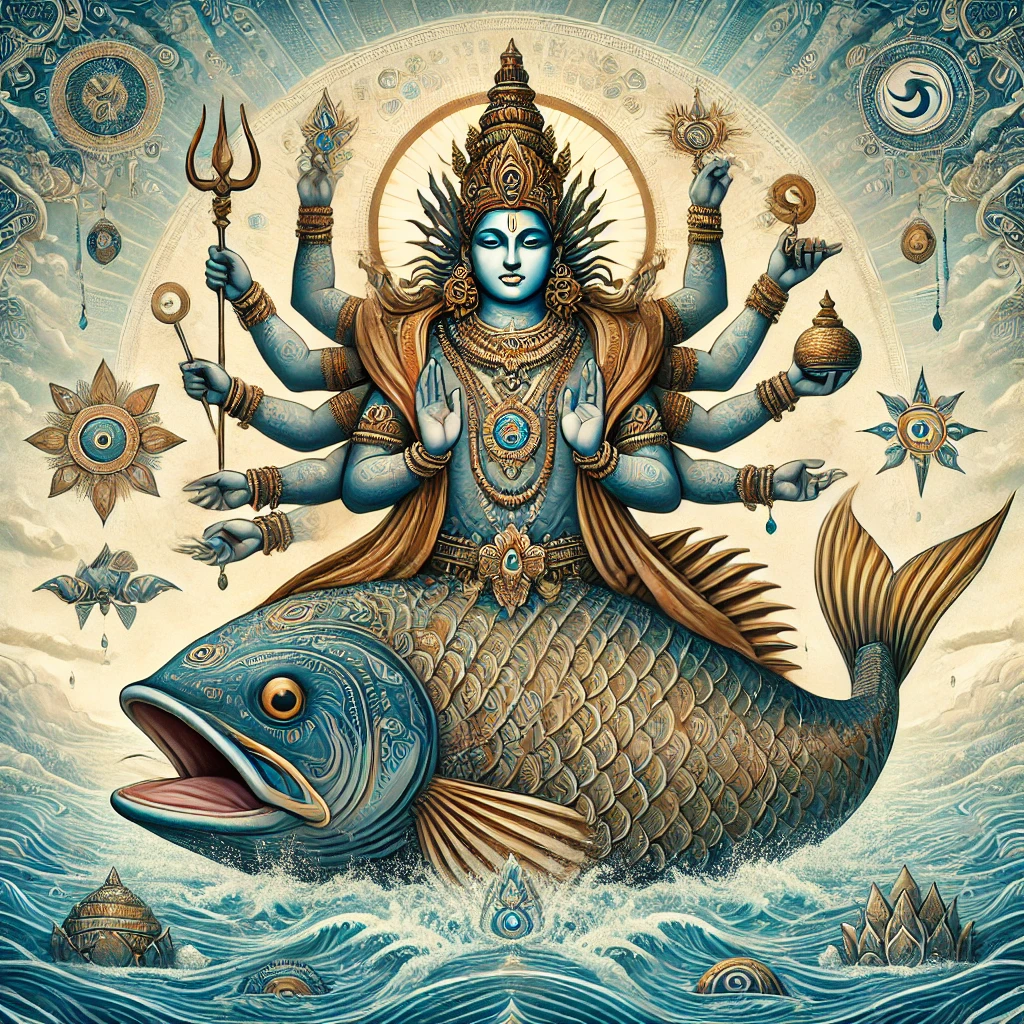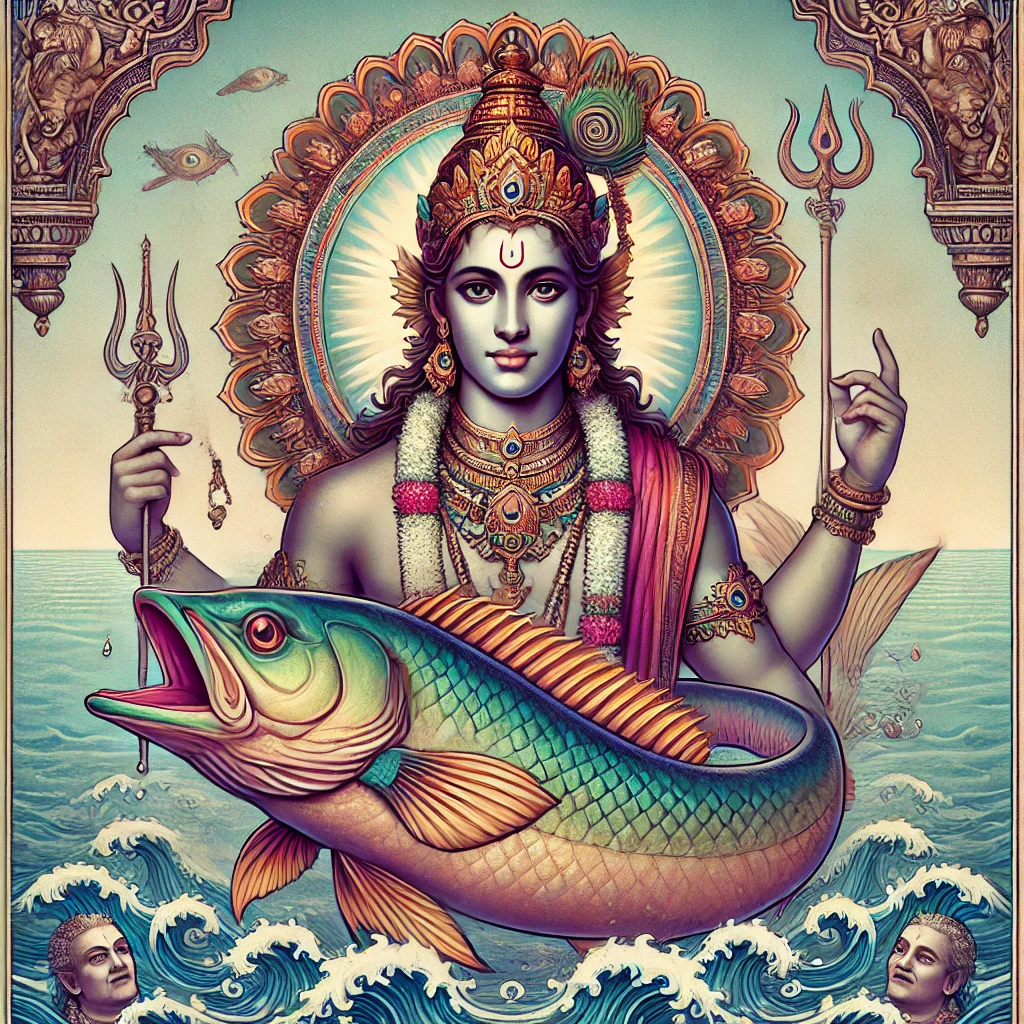Hindu mythology depicts Matsya Avatar, the first incarnation of Lord Vishnu, as a giant fish. People celebrate this avatar for saving the sacred Vedas and the sage Manu from a great flood. According to legend, Vishnu assumed the form of a fish to rescue Manu’s boat, which contained the Saptarishi (seven great sages), seeds of all plants, and one of every species of animal, ensuring the continuity of life on earth after the cosmic flood.
The Matsya Avatar narrative emphasizes themes of preservation and renewal, integral to Hindu cosmology. Vishnu, as the preserver, intervenes to restore cosmic order, demonstrating the divine’s commitment to protecting dharma. The avatar marks the beginning of the ten Dashavatara (ten incarnations) of Vishnu. Each avatar symbolizes the divine’s intervention during times of cosmic crisis, guiding humanity through cycles of creation and destruction.
In India, devotees dedicate the Matsya Temples in Aligarh, Chennai, and Kerala to the Matsya avatar of Vishnu. Artists adorn the temples with intricate carvings and sculptures. They attract devotees who seek blessings and wish to learn more about this unique aspect of Hindu mythology. The temples stand as a testament to the enduring significance of the Avatar in the religious and cultural fabric of India.
Matsya Avatar Idol
The Matsya Avatar idol is a striking representation of Lord Vishnu’s first incarnation as a fish. The divine form is traditionally depicted with the upper body of a man and the lower body of a fish. It symbolizes the transition from aquatic life to human form. The idol is meticulously crafted, often from stone, metal, or wood, with intricate detailing that captures Vishnu’s regal features. It is adorned with traditional ornaments and a serene expression.
In temples, the Matsya Avatar idol is usually enshrined in the sanctum, where it is the focal point of worship. The idol often holds significant symbols such as a conch and a discus, representing Vishnu’s divine powers. The artistic craftsmanship of the idol varies by region, reflecting local cultural influences. For instance, in Kerala, the idol may feature traditional Kerala-style carvings, while in North India, it might exhibit more ornate and elaborate designs.
The Matsya Avatar idol is not only a religious icon but also a piece of art that tells the story of Vishnu’s intervention to save the Vedas from the great flood. This narrative is vividly brought to life through the idol’s dynamic posture and detailed craftsmanship. It makes a profound symbol of protection, wisdom, and divine intervention in Hinduism. Devotees revere the idol, offering prayers, flowers, and other offerings to seek blessings and express their devotion to Lord Vishnu.

The Legend of Matsya Avatar
According to Hindu mythology, Matsya, often depicted as a fish or a half-man half-fish, is the first avatar Vishnu took to save the world from a great deluge. The primary sources of this story are the Matsya Purana, Bhagavata Purana, and other ancient scriptures.
Key Events in the Narrative
- The Alert and Rescue: King Satyavrata, a devoted worshiper of Vishnu, receives an alert about a close flood meant to destroy all life. Vishnu, appearing as a small fish, asks the king to save him from larger aquatic creatures. Recognizing the divine nature of the fish, Satyavrata vows to protect it.
- The Growth and Preparation: The fish grows rapidly. Satyavrata transfers it to larger and larger bodies of water, eventually placing it in the ocean. The fish then instructs Satyavrata to build a huge shelter and gather samples of all species, along with the seven sages (Saptarishi).
- The Flood and Preservation: When the flood started, Matsya lifted the shelter through the raging waters, protecting its inhabitants. During this time, Matsya also retrieved the stolen Vedas from a demon, thus preserving the sacred texts.
Symbolic Interpretation of Matsya Avatar
The Matsya Avatar, the first incarnation of Lord Vishnu, carries profound symbolic meanings that resonate deeply within Hindu philosophy and cosmology. It is represented as a giant fish. Matsya embodies various themes that highlight the intricate relationship between the divine, nature, and cosmic order.
Preservation and Renewal
Matsya Avatar symbolizes the principles of preservation and renewal, essential to maintaining the balance of the universe. The story of Matsya saving the Vedas and Manu during the great flood shows the protection of sacred knowledge and the continuity of life. This avatar highlights the cyclical nature of creation and destruction. It emphasizes on the need for renewal after periods of chaos and dissolution.
Divine Guidance and Protection
The narrative of Matsya guiding Manu’s boat through the turbulent waters signifies divine guidance and protection. This symbolizes the belief that the divine intervenes during times of crisis to steer humanity towards righteousness and safety. It highlights the role of Vishnu as the preserver. He ensures that dharma is upheld even in the face of existential threats.
Knowledge and Enlightenment
Matsya avatar’s rescue of the Vedas symbolizes the preservation and dissemination of spiritual knowledge. The Vedas are considered the foundational texts of Hindu philosophy and spirituality. Their protection by Matsya signifies the importance of safeguarding wisdom and enlightenment for future generations. This act highlights the value placed on knowledge and its role in guiding humanity towards moral and spiritual growth.
Environmental Harmony
The fish Matsya avatar also represents a harmonious relationship with nature. Water, being a symbol of life and fertility, signifies the nurturing aspect of the divine. Matsya’s aquatic form reminds devotees of the interconnectedness of all life forms and the importance of environmental conservation .

Cultural and Mythological Importance of Matsya Avatar
Matsya Avatar, the first incarnation of Lord Vishnu, holds significant cultural and mythological importance in Hinduism. Representing the theme of cosmic preservation, Matsya Avatar is central to Hindu cosmology and narratives of divine intervention. The story of Matsya saving the sacred Vedas and the sage Manu from a great flood illustrates Vishnu’s role as the preserver and protector of the universe.
Mythological Significance
In Hindu mythology, the Matsya Avatar is seen as a savior. The one who prevents the loss of sacred knowledge and ensures the survival of humanity and other life forms. This avatar highlights the cyclic nature of creation and destruction, emphasizing the importance of renewal and preservation. The story of Matsya guiding Manu’s boat, carrying the Saptarishi, seeds, and animals, marks the divine’s role in maintaining cosmic balance and order.
Cultural Impact
Culturally, Matsya Avatar is celebrated in various forms of art, literature, and religious practices. Temples dedicated to Matsya, such as the Matsya Temple in Aligarh, Uttar Pradesh. It serves as an important pilgrimage site, fostering a sense of devotion and continuity of tradition among followers. The depiction of Matsya in sculptures, paintings, and performances reflects the rich artistic heritage of India.
The Temple of Matsya Avatar
The Matsya Avatar temples in Aligarh, Chennai, and Kerala honor Lord Vishnu’s fish incarnation. These sacred sites feature intricate carvings and sculptures depicting the deity’s rescue of sacred texts during the cosmic deluge. Each temple offers unique architectural beauty and spiritual significance, attracting devotees and tourists alike.
Matsya Avatar Temple in Aligarh
The Matsya Avatar Temple in Aligarh is a respected shrine dedicated to Lord Vishnu’s fish incarnation. The temple showcases intricate architecture and exquisite sculptures that narrate the story of Matsya Avatar. The temple’s serene environment offers a peaceful retreat for devotees and visitors. The sanctum houses a beautiful idol of Lord Matsya, drawing worshippers from far and wide. They conduct regular rituals, festivals, and prayers here to celebrate the divine rescue mission. They make the Matsya Avatar Temple a significant spiritual and cultural landmark in Aligarh.
Matsya Avatar Temple in Chennai
Devotees highly regard the Matsya Avatar Temple in Chennai as another distinguished spiritual site dedicated to Lord Vishnu’s first incarnation as a fish. This temple features renowned Dravidian architecture, adorned with intricate carvings and vibrant sculptures. It depicts the divine tale of Vishnu rescuing sacred Vedas from a great flood. Devotees flock to the temple to offer prayers and participate in elaborate rituals and festivals celebrating this avatar. The serene ambiance and beautifully maintained temple grounds provide a tranquil space for meditation and devotion. The ambiance makes it a cherished landmark in Chennai’s rich cultural and religious landscape.
Matsya Avatar Temple in Kerala
Devotees highly respect the Matsya Avatar Temple in Kerala, a pilgrimage site dedicated to Lord Vishnu’s first avatar the divine fish. The temple features traditional Kerala architecture with intricate wood carvings and beautiful mural paintings that depict the Matsya Avatar story. The serene atmosphere and spiritual significance make this sacred place well-known. It attracts devotees who come to seek blessings and immerse themselves in the temple’s tranquil environment. People celebrate festivals like Matsya Jayanti with great fervor. The celebration makes the Matsya Avatar Temple a vital part of Kerala’s rich cultural and religious heritage.
The Matsya Temples play a crucial role in preserving the cultural heritage associated with the Matsya Avatar. Through its religious and cultural activities, the temple helps in disseminating the teachings and values embodied in the Matsya narrative. It emphasizes themes of preservation, renewal, and divine intervention. This temple not only stands as a place of worship but as a symbol of the enduring legacy of Hindu mythology as well.
Relevance
Understanding Matsya Avatar is vital for UPSC General Studies Paper I, covering Indian culture and religion. It provides insights into Hindu mythology, themes of preservation, and divine intervention, aiding in grasping deeper philosophical ideas. Familiarity with stories from texts like the Puranas helps answer questions on Indian literature. It offers historical context on religious practices and their societal impact. Knowledge of temples dedicated to Matsya Avatar enhances appreciation of ancient Indian art and architecture. Additionally, studying Matsya enables comparative analysis of mythological narratives across various cultures and religions, enriching the aspirant’s cultural and religious understanding.
| Matsya Avatar UPSC Notes |
| 1. Matsya Avatar, the first incarnation of Lord Vishnu in Hindu mythology, appears as a fish, symbolizing the beginning of life and the preservation of creation during the cosmic deluge. 2. The legend of Matsya Avatar involves Lord Vishnu saving the sacred Vedas and the sage Manu from a great flood, ensuring the continuity of knowledge and humanity. 3. Key events in the Matsya Avatar story include Vishnu’s transformation into a fish, guiding Manu’s boat through the deluge, and protecting the seeds of all life forms. 4. Matsya is often depicted as a fish with a human torso, sometimes holding the Vedas, symbolizing the divine intervention to preserve cosmic order and knowledge. 5. Prominent temples dedicated to Matsya Avatar in India include the Matsya Narayana Temple in Nagalapuram, Andhra Pradesh, which celebrates this incarnation with grandeur. 6. The idol of Matsya in these temples typically features Vishnu as a fish with a human upper body, often holding conch, discus, lotus, and mace, signifying his divine attributes. 7. The Matsya Avatar emphasizes the themes of preservation, the cyclical nature of time, and the importance of dharma (righteousness) in Hindu philosophy. 8. The significance of Matsya Avatar lies in its representation of the divine protection of life and knowledge, reinforcing the belief in Vishnu’s role as the preserver of the universe. |
